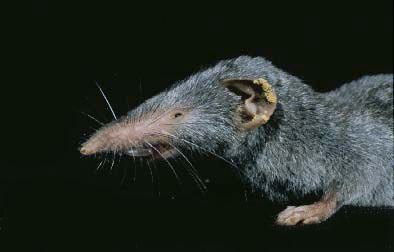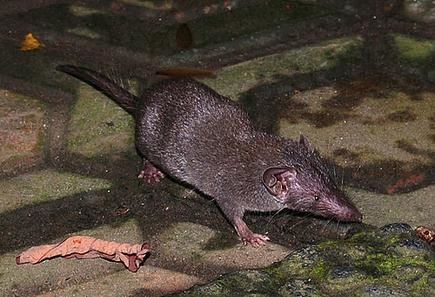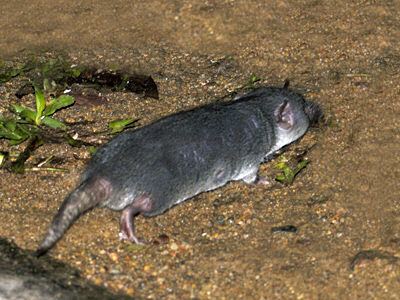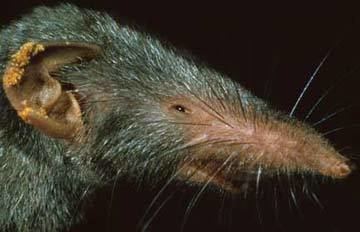Higher classification Suncus | Family Soricidae Scientific name Suncus murinus Rank Species | |
 | ||
Similar shrew, Suncus, Mammal, Crocidura, White‑toothed shrew | ||
The Asian house shrew (Suncus murinus) grey musk shrew, Asian musk shrew, or money shrew is a widespread, adaptable species of shrew found mainly in South Asia but introduced widely throughout Asia and eastern Africa.
Contents

It is a large shrew with a strong musk smell. It is related to the Etruscan shrew.
This species is locally called chuchunder in India and is mentioned in Rudyard Kipling's Jungle Book, as a nocturnal inhabitant of houses in India, by the name of chuchundra. However, Kipling's mistaken use of the name 'musk rat' has led to confusion with the unrelated North American muskrat (Ondatra zibethicus), and the latter species, not found in India, was (erroneously) illustrated in the Jungle Book.

This house shrew is categorized as a species of Least Concern on the IUCN Red List. It is also considered an invasive species and implicated in the demise of several island lizard species.

Asian house shrew suncus murinus
Distribution

Suncus murinus has a wide distribution throughout the Old World Tropics. In most of its range, it was introduced by man. According to Burton and Burton, it was originally native to the forests of India. It has been introduced by man to Sri Lanka, eastern Africa, Madagascar, islands in the Indian Ocean (Reunion, Comoros), Pacific Ocean (Guam, etc.), South-east Asia, China, southern Japan, Malaysia (Peninsular Malaysia, Sabah, Sarawak), Kalimantan, Brunei, Indonesia, New Guinea, and throughout Iran and Arabia to Egypt and Pakistan also.
Description

The house shrew has a uniform, short, dense fur of mid-grey to brownish-grey color. The tail is thick at the base and a bit narrower at the tip, and is covered with a few long, bristle-like hairs that are thinly scattered. They have short legs with five clawed toes. They have small external ears and an elongated snout. They also emit a strong odor of musk, derived from musk glands that are sometimes visible on each side of the body. The odor is especially noticeable during the breeding season.

Like all shrews, the Asian house shrew is plantigrade and long-nosed. The teeth are a series of sharp points to poke holes in insect exoskeletons. It is the largest of the shrew species, weighing between 50 and 100 g and being about 15 cm long from snout to tip of the tail.
Ecology and behaviour
S. murinus is a commensal species. It is a voracious insectivore with little resistance to starvation. It is active during the night, spending the day in a burrow or hiding place in human habitations. They breed throughout the year, with each female averaging two litters per year. The gestation period is one month. One to eight young are born per litter, usually three young, in a nest made by both of the parents, wherein the young stay until they are nearly adult. It starts breeding when it is around one year old.
Studies on this shrew have suggested its suitability for use in laboratory studies of reproduction and nutrition.
It is widespread and found in all habitats, including deserts and human habitations. The habitat of this species is normally near human settlement, specifically near the house. Some also live on the ground in leaf litter and grass. It has been recorded up to 2825 m above sea level near Darjeeling, West Bengal, but only to up to 300 m in Taiwan.
The house shrew has a habit of moving quickly along the edges of the walls when it enters human habitations. As it runs it makes a chattering sound which resembles the sound of jingling money, which has earned them the name ”money shrew” in China. When alarmed, the house shrew makes an ear-piercing, high-pitched shriek, resembling the sound of nails scraping a chalkboard or a metal fork scraping glass, which repels house cats. Predators also leave the house shrew alone because of its musky smell and even when they catch one by mistake they will rarely eat it.
Another remarkable habit of this shrew (shared with the white-toothed shrews of Europe) is that it forms a ”caravan” with its young, that is, the young line up behind the mother and follow it while she walks. The first young will hold on to the mother's fur with its teeth, and the subsequent young will do the same with the sibling in front of it.
Frequently misidentified as a rat or mouse, the house shrew is often eradicated as a pest. However, it plays a beneficial role for humans, primarily feeding on detrimental insects, including cockroaches and house mice, acting as a natural form of pest control. Unlike rats, the house shrew maintains low population levels. Despite its utility in insect management, the house shrew may become unwelcome due to the potent smell of its droppings, which are sometimes found in human residences, such as behind kitchen cupboards. It can also take to eating human food such as meat in kitchens, or dog or cat food. It is known to occasionally kill young chicks, making it unpopular with farmers, although rats probably kill more chicks, and more quickly. The way it is said to attack chicks, by first biting a tendon, immobilizing it and then killing and eating it, could indicate that it has a venomous bite that paralyses, as at least two other shrews species have (i.e. the Eurasian water shrew and the Northern short-tailed shrew).
